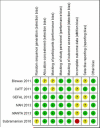Intravitreal Bevacizumab Versus Ranibizumab for Treatment of Neovascular Age-Related Macular Degeneration: Findings from a Cochrane Systematic Review
- PMID: 26477843
- PMCID: PMC4695272
- DOI: 10.1016/j.ophtha.2015.09.002
Intravitreal Bevacizumab Versus Ranibizumab for Treatment of Neovascular Age-Related Macular Degeneration: Findings from a Cochrane Systematic Review
Abstract
Topic: To summarize the relative effects of bevacizumab (Avastin; Genentech, Inc, South San Francisco, CA) and ranibizumab (Lucentis; Genentech, Inc.), using findings from a Cochrane Eyes and Vision Group systematic review.
Clinical relevance: Neovascular age-related macular degeneration (NVAMD) is the most common cause of uncorrectable vision loss among the elderly in developed countries. Bevacizumab and ranibizumab are the most frequently used anti-vascular endothelial growth factor (VEGF) agents injected intravitreally to treat NVAMD.
Methods: For this systematic review, we included only randomized controlled trials in which the 2 anti-VEGF agents had been compared directly. The primary outcome was 1-year gain in best-corrected visual acuity (BCVA) of ≥15 letters. We followed Cochrane methods for trial selection, data extraction, and data analyses. Relative effects of bevacizumab versus ranibizumab are presented as estimated risk ratios (RRs) and mean differences (MDs) with 95% confidence intervals (CIs).
Results: We identified 6 eligible randomized controlled trials with 2809 participants. The proportion of eyes that gained ≥15 letters of BCVA by 1 year was similar for the 2 agents when the same regimens were compared (RR, 0.90; 95% CI, 0.73-1.11). The mean change in BCVA from baseline also was similar (MD, -0.5 letter; 95% CI, -1.6 to +0.6). Other BCVA and quality of life outcomes were similar for the 2 agents. One-year treatment cost with ranibizumab was 5.1 and 25.5 times the cost for bevacizumab in the 2 largest trials. Ocular adverse events were uncommon (<1%), and rates were similar for the 2 agents.
Conclusions: We found no important difference in effectiveness or safety between bevacizumab and ranibizumab for NVAMD treatment, but there was a large cost difference.
Copyright © 2016 American Academy of Ophthalmology. Published by Elsevier Inc. All rights reserved.
Figures




References
-
- Gragoudas ES, Adamis AP, Cunningham ET, et al. Pegaptanib for neovascular age-related macular degeneration. N Engl J Med. 2004;351:2805–16. - PubMed
-
- Rosenfeld PJ, Brown DM, Heier JS, et al. Ranibizumab for neovascular age-related macular degeneration. N Engl J Med. 2006;355(14):1419–31. - PubMed
-
- Brown DM, Kaiser PK, Michels M, et al. Ranibizumab versus verteporfin photodynamic therapy for neovascular age-related macular degeneration. N Engl J Med. 2006;355:1432–1444. - PubMed
Publication types
MeSH terms
Substances
Grants and funding
LinkOut - more resources
Full Text Sources
Other Literature Sources
Medical
Molecular Biology Databases
Research Materials
Miscellaneous

